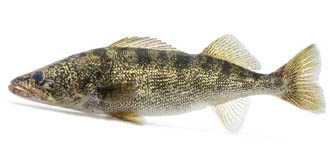Walleye Fish Nutrition facts
The walleye, scientifically known as Sander vitreus, is a freshwater ray-finned fish belonging to the family Percidae (Perch), native to North America. Renowned for its delectable flavor, it is a favored catch among recreational anglers.
It is also referred to by various common names such as walleyed pike, yellow pike, yellow walleye, pickerel, pike-perch, dory, and freshwater perch.
 |
| Walleye. Courtesy: U.S. Fish & Wildlife Service-Mountain Prairie |
Description:
Walleye possess a distinctive appearance characterized by large, glassy eyes, sharp teeth, and an elongated, cylindrical body. They typically display hues of olive-green or gold, accompanied by a white belly and mottled sides. Adults can attain lengths of up to 30 inches and weigh as much as 20 pounds.
Habitat & Biology
Walleye inhabit various freshwater environments, including lakes, rivers, and reservoirs. They exhibit a preference for clear, cool waters with moderate currents and substrates ranging from sand and gravel to boulders and bedrock.
As carnivores, walleye prey upon various species, including minnows, shad, crayfish, and insects. They are often most active during low-light periods, such as dawn and dusk.
Typically spawning in spring, walleye select water temperatures ranging from 42 to 50 degrees Fahrenheit. Females have the capacity to lay up to 500,000 eggs, which adhere to a substrate in shallow water. Upon hatching, larvae primarily feed on zooplankton before transitioning to a diet of small fish.
In their natural habitat, walleye can live for up to 20 years. However, their lifespan is often shortened in commercial settings due to stress and other factors.
Both walleye and pike-perch are members of the perch family, and they are both considered relatively lean, healthy fish options. Walleye holds 93 cal/3.5 oz. In comparison, Arctic char has 186 cal/3.5 oz (100g).
The American Heart Association recommends consuming at least 2 servings of oily fish like Walleye to fulfill requirements for essential fatty acids, protein, minerals, and fat-soluble vitamins.
The characteristic pink or orange-red color of Walleye flesh comes from the fat-soluble carotenoid pigment astaxanthin, which normally exists in crustacean flesh like shrimp.
Astaxanthin is known for its antioxidant and anti-inflammatory properties and is believed to have numerous potential health benefits. It is a biologically stable antioxidant, several hundred times more powerful than vitamin C and Co-enzyme Q10.
Walleye fish's flaky, orange-pink flesh is a rich source of vitamins A, D, and E, and long-chain omega-3 fatty acids (PUFA).
It is an excellent source of protein; 3.5 oz of walleye meat provides 19.1 g (34% of daily required levels). Its flesh is complete in the sense that it comprises all the essential amino acids required for optimal growth and development.
Walleye fish is a good source of omega-3 fatty acids, including eicosapentaenoic acid (EPA), docosapentaenoic acid (DPA), and docosahexaenoic acid (DHA). Research studies suggest that these fatty acids, particularly DHA, play an important role in the development of neural systems, especially in infants and children.
In adults, several large trials have evaluated the effect of fish or fish oils on heart disease. In the "GISSI Prevention Trial, heart attack survivors who took a 1-gram capsule of omega-3 fats every day for three years were less likely to have a repeat heart attack, stroke, or die of sudden death than those who took a placebo".
Walleye flesh is one of the finest sources of some B-complex vitamins such as niacin (vitamin B3: provides 53% RDI/100 g), pyridoxine, and riboflavin.
Walleye fillets comprise 70 IU/3.5 oz of Vitamin-A. Vitamin-A and omega-3 are essential for healthy mucosa and skin.
The Food and Drug Administration (FDA) recommends that pregnant women can eat at least 8 ounces and up to 12 ounces (340 grams) of a variety of seafood lower in mercury per week.
Furthermore, Walleye comprises significant amounts of essential minerals like calcium, phosphorus, and magnesium. In this marine fish, other trace elements commonly found are selenium and iodine.
| Principle | Nutrient Value | Percent of RDA |
|---|---|---|
| Energy | 93 Kcal | 4.7% |
| Carbohydrates | 0 g | 0% |
| Protein | 19.1 g | 34% |
| Total Fat | 1.22 g | 6.1% |
| Cholesterol | 86 mg | 28% |
| Dietary Fiber | 0 g | 0% |
| Vitamins | ||
| Folates | 15 μg | 4% |
| Niacin | 2.3 mg | 14% |
| Pyridoxine | 0.12 mg | 9% |
| Riboflavin | 0.207 mg | 16% |
| Thiamin | 0.27 mg | 22.5% |
| Vitamin-A | 70 IU | 2.33% |
| Vitamin-C | 0 mg | 0% | Electrolytes |
| Sodium | 51 mg | 3.4% |
| Potassium | 389 mg | 8% |
| Minerals | ||
| Calcium | 110 mg | 11% |
| Iron | 1.3 mg | 16% |
| Magnesium | 30 mg | 7.5% |
| Phosphorus | 210 mg | 30% |
| Zinc | 0.62 mg | 5.7% |
| Omega-3 fats (PUFA) | ||
| EPA (20:5 n-3) | 0.086 g | -- |
| DPA (22:5 n-3) | 0.038 g | -- |
| DHA (22:6 n-3) | 0.225 g | -- |
Buying
When purchasing walleye fish, it is crucial to consider factors such as freshness, appearance, source, size, preparation, and sustainability. Larger walleye typically exhibit firmer texture and a more robust flavor profile. Various options are available, including whole (round), headless, dressed, fillets (skinless/skin-on), as well as frozen IQF fillets or IQF fingers, commonly found in seafood specialty stores.
To assess the freshness of whole walleye, inspect the flesh and skin, as clear, bright eyes are not necessarily indicative of freshness; rather, the eyes naturally appear flat and opaque. Additionally, ensure the walleye's skin appears bright and shiny, with intact scales. For filleted walleye, scrutinize the label to ensure it originates from clean, cold waters, which typically denotes higher quality.
Storage
If you possess fresh walleye and do not intend to cook it immediately, it can be refrigerated for up to 2-3 days. Ensure to store the fish in an airtight container or tightly wrap it in plastic to prevent air exposure, which can cause the flesh to dry out.
Preparation
Walleye, a delicious cold-water fish, boasts abundant omega-3 fatty acids and protein. Its versatility in cooking methods—whether frying, grilling, or baking—makes it a favorite, although certain sizes or cuts may fare better with specific techniques.
Walleye fillets are prized for their thickness and succulent, sweet, mild flavor. With its minimal bones, walleye becomes even more appealing during the cooking process. While raw walleye displays a rich pink hue, it transforms into a clear white when cooked.
Here are some serving ideas:
Avoid excessive seasoning or cooking techniques with walleye; simple preparations are the best way to showcase the succulent, delicate flavor.
 |
| Walleye recipe. Credit: Edsel Little |
For grilling, simply brush a fillet with lemon butter. If you must embellish the fish, use a light touch with sauces such as white wine, garlic, or dill.
Golden brown and crispy, pan-fried walleye is a popular dish in Canadian Great Lake restaurants.
Enjoy grilled walleye fillets seasoned with salt, pepper, and your favorite herbs and spices.
Baked walleye is a healthy alternative seasoned with salt, pepper, herbs, and spices. Bake for 15-20 minutes, until the fish is cooked through and flakes easily with a fork.
Serve hot walleye chowder with crusty bread.
Walleye fish cakes are a popular Minnesota state fair delicacy.
Safety Profile
According to the U.S. FDA guidelines, walleye fish, with methyl mercury levels ranging from 0.11 to 0.44 parts per million (ppm), falls into the "best choice" category for expectant and breastfeeding mothers. As per these guidelines, it is recommended to consume 2-3 servings of walleye per week. For more information, refer to the medical disclaimer.
Also read ≻≻-
≻≻- Arctic Char nutrition facts and health benefits.
≻≻- Chinook Salmon nutrition facts and health benefits.
≻≻- Atlantic Cod nutrition facts and health benefits.
≻≻- Brook Trout nutrition facts and health benefits.
≺≺ Back to Seafood from Walleye fish nutrition facts and health benefits.
Further reading (Links opens in new window):
NOAA Fisheries-Fisheries and Oceans Canada.
Omega-3 Fatty Acids: An Essential Contribution.